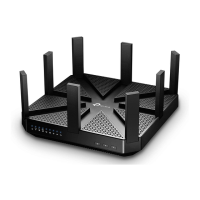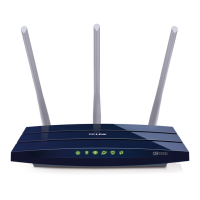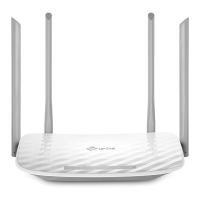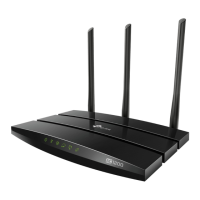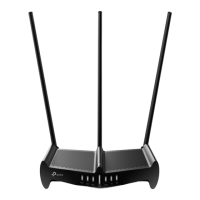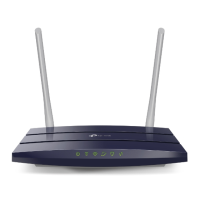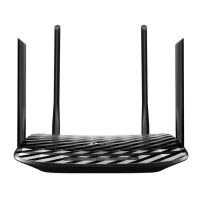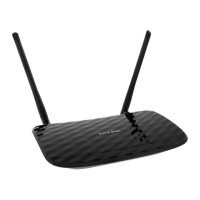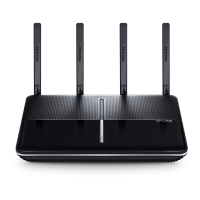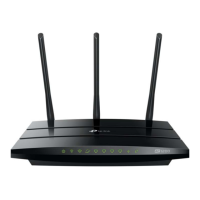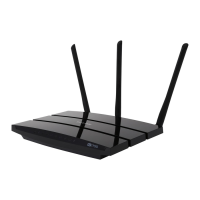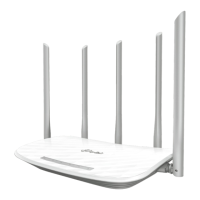Do you have a question about the TP-Link Archer C5400X and is the answer not in the manual?
Overview of the router's features, performance, and ease of use.
Details the physical layout of the router's components and indicators.
Guidance on selecting an optimal location for the router for best performance and safety.
Instructions on physically connecting the router to power and the network.
Steps to access the router's web management interface.
Guides users through a simplified router setup process using a wizard.
Explains how to set up the router using the TP-Link Tether app via Bluetooth.
Provides steps to manually configure internet connection settings based on ISP information.
Instructions to configure the router to function as an access point in an existing network.
Details how to configure the router for an IPv6 internet connection.
Explains how to use WAN Aggregation to combine ports for higher bandwidth.
Steps to create and activate a TP-Link ID for cloud services.
Guide on how to update email address and password for your TP-Link ID.
Instructions on adding, removing, and managing TP-Link IDs for router access.
How to use the TP-Link Tether app for router management on mobile devices.
Steps to set up a separate Wi-Fi network for guests to enhance security.
Configure a captive portal for guest network access, often used for promotions.
Options to configure guest network behavior, security, and privacy settings.
How to connect and access files on USB storage devices connected to the router.
Enables viewing media files from USB storage on DLNA-supported devices.
Allows sharing a USB printer connected to the router across the network.
Configure router for Time Machine backups from Mac computers.
Set internet access restrictions, daily limits, and schedules for family members.
Prioritize internet traffic for specific applications or devices to ensure smooth performance.
Built-in antivirus provides malicious content filtering and intrusion prevention.
Configure SPI Firewall to protect the router and network from online threats.
Block or allow specific devices to access the network using Blacklist or Whitelist.
Bind device IP addresses to MAC addresses to prevent ARP spoofing and attacks.
Share local resources like websites or servers with the internet using port forwarding.
Dynamically open ports for specific applications based on triggering port connections.
Expose a PC to the internet with all ports open for unlimited communication.
Enable UPnP for seamless online gaming and other applications.
Set up an OpenVPN server for secure remote access to your home network.
Configure a PPTP VPN server for remote access, offering speed over security.
Modify the router's LAN IP address and subnet mask for network configuration.
Combine router ports to create a single high-bandwidth wired connection.
Set up the router for Internet/IPTV/Phone services provided by your ISP.
Configure the DHCP server to assign IP addresses to network devices.
Set up DDNS to access your router remotely using a domain name.
Manually configure routing entries to direct network traffic to specific destinations.
Customize SSID, password, security, and other wireless network parameters.
Use Wi-Fi Protected Setup for easy and secure wireless connection.
Automatically turn the wireless network on or off at scheduled times.
Configure the router's system time from the internet or your computer.
Enable Night Mode to turn off router LEDs during specific periods.
Use Ping or Traceroute to diagnose network connection issues.
Monitor current upload and download speeds and view speed test history.
Update the router's firmware for new features and security enhancements.
Save and load router settings for backup or recovery purposes.
Schedule automatic reboots to maintain router performance and stability.
Modify the password used to access the router's web management page.
Set up a system to recover your router's login password if forgotten.
Control which devices on the LAN can manage the router using MAC authentication.
Configure settings to allow or deny remote access for router management.
Save or email system logs for troubleshooting router issues.
View network traffic usage for all connected devices or individual devices.
Steps to retrieve or reset the wireless password if forgotten.
Methods to recover or reset the router's web management login password.
Troubleshooting steps for issues preventing access to the router's web interface.
Steps to reset the router if it cannot be found via Bluetooth in the Tether app.
Troubleshooting steps when internet access is unavailable after setup.
Solutions for issues related to finding or connecting to wireless networks.
Overview of the router's features, performance, and ease of use.
Details the physical layout of the router's components and indicators.
Guidance on selecting an optimal location for the router for best performance and safety.
Instructions on physically connecting the router to power and the network.
Steps to access the router's web management interface.
Guides users through a simplified router setup process using a wizard.
Explains how to set up the router using the TP-Link Tether app via Bluetooth.
Provides steps to manually configure internet connection settings based on ISP information.
Instructions to configure the router to function as an access point in an existing network.
Details how to configure the router for an IPv6 internet connection.
Explains how to use WAN Aggregation to combine ports for higher bandwidth.
Steps to create and activate a TP-Link ID for cloud services.
Guide on how to update email address and password for your TP-Link ID.
Instructions on adding, removing, and managing TP-Link IDs for router access.
How to use the TP-Link Tether app for router management on mobile devices.
Steps to set up a separate Wi-Fi network for guests to enhance security.
Configure a captive portal for guest network access, often used for promotions.
Options to configure guest network behavior, security, and privacy settings.
How to connect and access files on USB storage devices connected to the router.
Enables viewing media files from USB storage on DLNA-supported devices.
Allows sharing a USB printer connected to the router across the network.
Configure router for Time Machine backups from Mac computers.
Set internet access restrictions, daily limits, and schedules for family members.
Prioritize internet traffic for specific applications or devices to ensure smooth performance.
Built-in antivirus provides malicious content filtering and intrusion prevention.
Configure SPI Firewall to protect the router and network from online threats.
Block or allow specific devices to access the network using Blacklist or Whitelist.
Bind device IP addresses to MAC addresses to prevent ARP spoofing and attacks.
Share local resources like websites or servers with the internet using port forwarding.
Dynamically open ports for specific applications based on triggering port connections.
Expose a PC to the internet with all ports open for unlimited communication.
Enable UPnP for seamless online gaming and other applications.
Set up an OpenVPN server for secure remote access to your home network.
Configure a PPTP VPN server for remote access, offering speed over security.
Modify the router's LAN IP address and subnet mask for network configuration.
Combine router ports to create a single high-bandwidth wired connection.
Set up the router for Internet/IPTV/Phone services provided by your ISP.
Configure the DHCP server to assign IP addresses to network devices.
Set up DDNS to access your router remotely using a domain name.
Manually configure routing entries to direct network traffic to specific destinations.
Customize SSID, password, security, and other wireless network parameters.
Use Wi-Fi Protected Setup for easy and secure wireless connection.
Automatically turn the wireless network on or off at scheduled times.
Configure the router's system time from the internet or your computer.
Enable Night Mode to turn off router LEDs during specific periods.
Use Ping or Traceroute to diagnose network connection issues.
Monitor current upload and download speeds and view speed test history.
Update the router's firmware for new features and security enhancements.
Save and load router settings for backup or recovery purposes.
Schedule automatic reboots to maintain router performance and stability.
Modify the password used to access the router's web management page.
Set up a system to recover your router's login password if forgotten.
Control which devices on the LAN can manage the router using MAC authentication.
Configure settings to allow or deny remote access for router management.
Save or email system logs for troubleshooting router issues.
View network traffic usage for all connected devices or individual devices.
Steps to retrieve or reset the wireless password if forgotten.
Methods to recover or reset the router's web management login password.
Troubleshooting steps for issues preventing access to the router's web interface.
Steps to reset the router if it cannot be found via Bluetooth in the Tether app.
Troubleshooting steps when internet access is unavailable after setup.
Solutions for issues related to finding or connecting to wireless networks.
| Color | black/red, black |
|---|---|
| Wi-Fi Speed | 5.334 gigabits per second |
| Band Technology | tri |
| Frequency Band | 2.4 ghz, 5.0 ghz |
| Ethernet Standard | 10/100/1000 |
| Ethernet Switch | yes |
| Wireless Networking Standard | wi-fi 5 |
| Wireless Standard | ac, n |
| 2.4 Ghz Streams | 1 |
| 5.0 Ghz Streams | 2 |
| Gigabit Ethernet Speed | yes |
| Antennas | 8 |
| Parental Control | yes |
| Firewall | none |
| Data Encryption | yes |
| Encryption Type | wpa, wpa2, wpa-psk, wpa2-psk |
| Ports | rj-45, usb |
| LAN Ports | 8 |
| WAN Ports | 1 |
| Built In Modem | yes |
| Height | 2.2 inches |
|---|---|
| Width | 9.5 inches |
